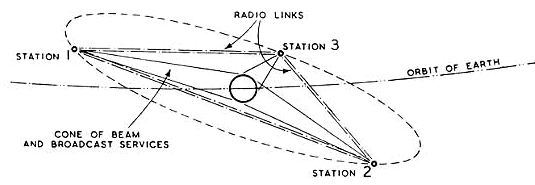Captain Marvel, Marvel’s Captain Marvel – Carol Danvers that is – has a new assignment and new digs.
In the latest Captain Marvel #1 issue from Marvel, Carol takes the job as the Commander of the Alpha Flight Space Station, Earth’s first line of defense. The massive station is crewed by a full-time team of technicians, engineers, staff and, as the name suggests, members of the Canadian super-team, Alpha Flight.
As Carol is ascending to the station from the top of the Triskelion, she monologues about her duty – she’s signed on for two years as the commander of “a space station in a geostationary orbit, 250 kilometers above the earth’s surface.”
While we wish Carol the best (although, from the looks of the end of the first issue, things are going to be a little dicey for a while), we want to nail down that orbit: geostationary. What does that mean, exactly?
Satellites are a staple in superhero comics, with most teams occupying a satellite at some time in their history, and two words are used to describe where they are: geostationary (GSO) and/or geosynchronous (GEO).
Let’s focus in on Carol’s command – the A.F.S.S. (Alpha Flight Space Station) in a geostationary orbit.
We’re going to leave a full look at satellites for a future article (along with why the Justice League’s satellite has a really bad habit of falling), so for now, we’re going to take a light look at geostationary orbits. First – the name helps out with the “what” of the orbit. A geostationary orbit is a circular orbit around the earth where the satellite appears to be over the same location on earth all the time, night and (if you could see it) day.
For that to happen, there are a few requirements:
- First, the satellite has to be travelling around the earth just as fast as the earth is spinning, that is, making the full rotation in one sidereal day, 23 hours, 56 minutes – which means it has to be traveling at 3.07 km/s.
- Second – to truly be geostationary, there’s only one location for your orbit: directly above the equator. Anywhere else won’t work if you’re looking to stay over the same place on the earth 24/7.
- Finally, there’s a height requirement – roughly 35,786 km (22,236 mi). It’s a high orbit. Orbits at this latitude and at this height are geostationary, anything that isn’t….well, isn’t. All geostationary satellites are located in this artificial ring around the earth. Through the magic of Kepler’s third law, there is only one geostationary orbit.
To sum it all up – in order to stay in the same place, the time it takes to orbit has to match the time it takes the earth to spin around its axis once. The only, only altitude at which it can do that is 35,786 km above the equator. In order to maintain a stable orbit closer to the earth, you have to move faster (the International Space Station, in low earth orbit, circles the planet about every 90 minutes, meaning it’s zooming, relative to a geostationary satellite – about 8000 m/s); while to maintain a stable orbit that’s more than a sidereal day, you have to move higher.
A moment for clarification – a geostationary orbit is a type of geosynchronous orbit. A geosynchronous orbit is any orbit that has a period (how long it takes to go around the earth) that is equal to the time it takes the earth to rotate once (the earth’s rotational period). So all geostationary orbits are geosynchronous, but not all geosynchronous orbits are geostationary. Try not to use them interchangeably.
The idea of geostationary satellites had been around for almost 20 years when Arthur C. (Childhood’s End, 2001: A Space Odyssey) Clarke wrote the article, “Extra-Terrestrial Relays — Can Rocket Stations Give Worldwide Radio Coverage?” for Wireless World magazine in October, 1945. Clarke’s proposal, which turned out to be accurate, was that geostationary satellites could be used for communication, since being in the same plane as the equator would allow the satellites’ transmissions to reach a very large swath of either the northern or southern hemisphere. Clarke’s vision called for three geostationary communications satellites that would allow for worldwide communication. Something we take for granted today. By the way, the orbit that’s home to geostationary satellites is sometimes referred to as the Clarke Orbit in honor of the author.
The Clarke Orbit is a crowded one, with many countries jockeying for position in the ring for their own satellites, and champing at the bit when a satellite leaves the orbit (which can be planned or due to a malfunction). Placement of geostationary satellites has to be coordinated carefully – too close, and their signals may well interfere with each other, and since there will be some movement within the orbit, geostationary satellites that are too close could ultimately smack into one another, and that would be…bad.
As with all satellites, getting there is only part of the challenge – most often at least a two step process where the satellite is first put into a “transfer orbit.” Staying in your preferred orbit is the other issue facing a station or satellite in geostationary orbit. Since all the bodies that exert gravitational forces aren’t lines up in a nice straight line, the sun and moon act to pull geostationary satellites up or down out of the plane of the equator, while the non-circular shape of the equator tends to pull satellites above it towards one of two stable points, resulting in movement east-west.
 To stay where they need to be all geostationary satellites have enough fuel and maneuvering rockets to correct their orbit as needed, which is called stationkeeping. In our world, when a satellite finally runs out of fuel for stationkeeping maneuvers, it’s lifespan is up, and it will either eventually fall back to earth, burning up in the atmosphere on the way down, or the last of its fuel will be used to bump the satellite into a higher orbit, keeping it out of the way of other geostationary satellites.
To stay where they need to be all geostationary satellites have enough fuel and maneuvering rockets to correct their orbit as needed, which is called stationkeeping. In our world, when a satellite finally runs out of fuel for stationkeeping maneuvers, it’s lifespan is up, and it will either eventually fall back to earth, burning up in the atmosphere on the way down, or the last of its fuel will be used to bump the satellite into a higher orbit, keeping it out of the way of other geostationary satellites.
Of course, with a little orbital mechanics, virtually all of the movements of a geostationary satellite can be planned out well in advance, and programmed into the computers on board.
If all of this doesn’t work for you – and you want a geostationary orbit somewhere else, that’s no problem. Physics and orbital mechanics allow for that. The only thing is that you’re going to have to provide the energy to maintain your geostationary orbit, which is going to take fuel that’s going to affect your mass, and will need to be constantly replenished, oh, and your thrusters better never wear out, either…or the earth is probably going to bring you in for a big old hug.











